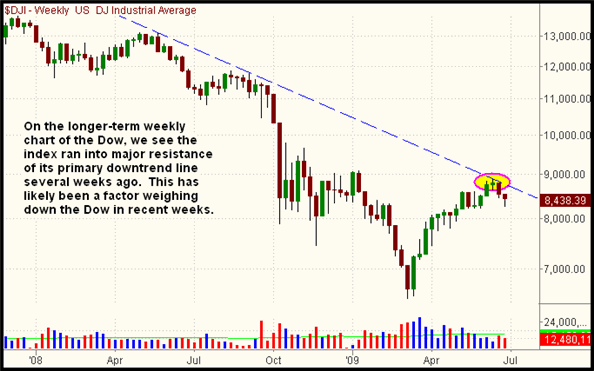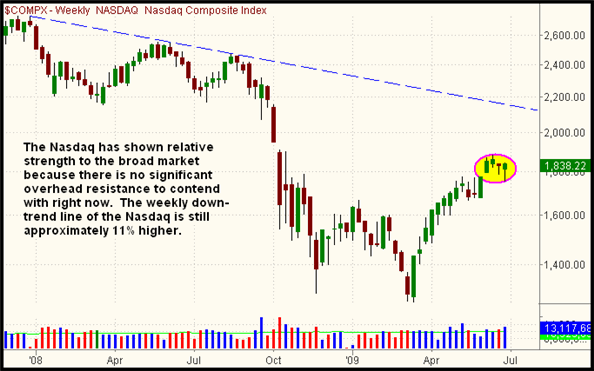|
The Wagner Daily ETF Report For June 29
Stocks finished a choppy week of trading with a round of narrow-ranged, indecisive trading that caused the major indices to finish with mixed results last Friday. The Nasdaq Composite, which drifted higher throughout the day, gained 0.5%. However, the S&P 500 and Dow Jones Industrial Average slipped 0.1% and 0.4% respectively. The small-cap Russell 2000 advanced 0.7%, as the S&P Midcap 400 closed 0.2% higher. The Nasdaq Composite finished near the top of its intraday range. The S&P and Dow closed just above the middle of their ranges. As with Friday's session, results for the week were also mixed. The Nasdaq rallied 0.6%, but the Dow lost 1.2%. The benchmark S&P 500 declined 0.3%.
Total volume in the NYSE surged 73% above the previous day's level, while volume in the Nasdaq similarly swelled 58%. But even though volume rocketed higher, the higher turnover was deceiving, as it was completely related to the annual rebalancing of the Russell indexes. Every June, Russell Investments' popular small and micro cap indexes are adjusted by removing underperforming companies and adding better replacements. When this occurs, index funds tied to the Russell indexes are automatically forced to adjust their portfolios to match the changes. In the case of last Friday's session, overall volume was actually on pace to be slightly lower than the previous day's level until the last fifteen minutes of trading. Since the monstrous volume spike into the close appears to be fully attributed to the forced Russell rebalancing, the Nasdaq essentially did not score a bullish "accumulation day," and the S&P did not register a bearish "distribution day."
As we enter the holiday-shortened week, the broad market remains at a key, intermediate-term inflection point. Last week, the S&P 500 bounced after testing key support of its 50 and 200-day moving averages. The laggard Dow recovered after becoming the first of the major indices to kiss support of its May 2009 lows, but the index closed just below resistance of its 200-day MA, for the second day in a row. The relatively strong Nasdaq has been holding up the best, as the index fully held above its 50-day MA during last week's pullback, and remain well above its 200-day MA. While the Dow was testing its May 2009 lows, the Nasdaq found support near its May 2009 highs. Clearly, divergence within the broad market is becoming quite apparent. The resilient Nasdaq is giving the bulls hope, while the unenthusiastic Dow is drawing the bears out of hibernation.
One thing that may shed some light on the short-term divergence between the Dow and Nasdaq is a comparison of the patterns on their longer-term weekly charts. Let's start with the weekly chart of the Dow Jones Industrial Average:

Notice how the Dow ran into resistance of its long-term downtrend line several weeks ago (circled in pink). Since the downtrend has been in place for so long, that trendline undoubtedly has been a factor in the recent relative weakness of the blue-chip index. Although the Dow could easily pop above that downtrend line on its next rally, it wasn't likely to do so on the initial test of resistance several weeks ago. Now, the Dow's challenge will be to overcome the bearish "head and shoulders" pattern that is forming on the shorter-term daily chart. If it doesn't, expect the index to make another leg down, below its May 2009 lows, in the short-term. But a rally above its June high would invalidate the "head and shoulders," and also cause the Dow to break out above its weekly downtrend line. Next, check out the weekly chart of the Nasdaq:

Unlike the Dow, the Nasdaq still has quite a way to go (approximately 11%) before kissing its long-term downtrend line. That lack of major overhead resistance has been a key factor in enabling the Nasdaq to show relative strength in recent weeks. With no major resistance levels to contend with right now, the Nasdaq could see smooth sailing to new highs within its current uptrend.
With the stock market at a pivotal inflection point, what clue might help us to predict the direction of the broad market's next move? Most likely, it will all come down to who wins the tug-of-war between the bulls of the Nasdaq and bears of the Dow. If the Nasdaq manages to breakout above its June 11 high, one could expect the Dow to be pulled along with it. Conversely, if the Dow breaks support of its May low first, one could similarly expect the Dow to drag the Nasdaq lower. But until either scenario occurs, we should be prepared for more whippy, indecisive trading conditions. Since the stock market is closed this Friday (for Independence Day holiday), light volume ahead of the holiday could exacerbate any choppy price action.
Open ETF positions:
Long - IBB, UNG, SLV, DBA, SKF
Short - (none, but SKF is an inversely correlated ETF)
Deron Wagner is the Founder and Head Trader of both Morpheus Capital LP, a U.S. hedge fund, and MorpheusTrading.com, a trader education firm.
|